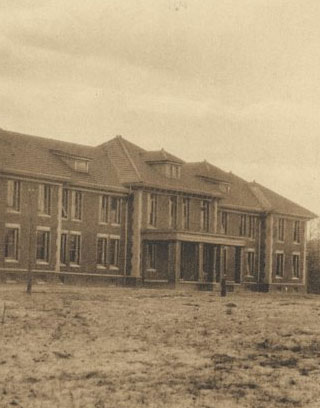
Opened in 1909 as the original Girls Dormitory, Wilson Hall also served as early faculty housing. It was named for Claude Wayland Wilson, East Carolina Board of Trustees member and director of summer school from 1909-1922. The building was also notable for its Pergola, whose stylistic influence is still evident on campus, most notably near West End Dining Hall. The building was demolished in 1968 to provide space for the Jenkins Fine Arts Center.
- Other names
- Girls Dormitory
- Built
- 1909
- Razed
- 1968
- Construction cost
- $26,469.12 bid
- Architects
- Hook & Rogers, Charlotte, NC
- Namesake
- Claude Wayland Wilson (1867-1922). Graduated from Wake Forest in 1893. Teacher, school principal and superintendent in Eastern North Carolina, 1893-1909. Secretary and Bursar for the Board of Trustees and Director of the summer term at ECTTS, 1909-1922.
The death of C.W. Wilson was reported in Volume 2, page 29 of the Board of Trustees Meeting Minutes. Robert H. Wright recorded the following:On February 1, C. W. Wilson, Secretary of the Board of Trustees, died suddenly. Wilson was one of the original Board of Trustees, and from the organization of the Board of Trustees until his death was Secretary to the Board. He was Director of the Summer School and in my absence was the person to whom I turned over the administrative duties of the College. His death is the most serious blow the College has ever had when viewed from the internal workings of the institution. He understood thoroughly our state's educational needs, and worked indefatigably to meet those needs. He literally gave his life for the children of North Carolina. In his going our state has lost one of its best citizens and one of its most unselfish public servants. This College has lost one of its strongest workers, one of its best teachers, and one of its most loyal and enthusiastic spirits. His place cannot be filled. In fact we do not want to fill it, but his going necessitates a reorganization and readjustment. We are in the midst of making these changes. The spirit of our teachers and officers as it manifests itself at this trying time to the administration of the College is most loyal and most commendatory and as your executive officer I want to lay these facts before you. Respectfully submitted, Robert H. Wright, President
- History
- One of four original buildings of East Carolina Teachers Training School, built with Spanish architectural influences. Originally constructed to house women students and faculty. In 1920 the building was renovated: Training School Quarterly, Volume 8, 1920, p. 90:
In the west dormitory the rooms at the east end of the front hall have been remodeled and built into very attractive parlors. The parlors are shut off from the other part of the dormitory by doors. "Moving day" was celebrated on November 12 and 13. The contractors promised President Wright to have the new wing ready by September 28th. President Wright had faith in this promise and word was sent to the girls to come. But the new wing was not finished. It was then promised to be completed in two weeks. The girls were allowed to stay here if they were willing to put up with camping three or four in a room. The rooms were crowded with beds, hardly room enough to move around; when the girls went to visit each other, they had to sit on the beds while being entertained because the rooms were too crowded to contain chairs. At the end of two weeks the building seemed no nearer completion so we were still kept in suspense. At the end of the seventh week the command was given to "move." The day before, November 12, the teachers moved from their quarters on the upper floor on the old front to the first floor of the new wing. They occupy the entire first floor of the new wing and have the same entrance as before. On November 13 the girls moved to the upstairs of the new wing and also occupy the rooms upstairs formerly occupied by the teachers. On that same day and on November 15 was camp cleaning day for those who did not have to move. The girls made the best of the situation and had a jolly time. There never has been a year at the the Training School when the girls had a better chance to know each other than the opportunity afforded this year. The building was demolished in 1968 to make part of the site for the Jenkins Fine Arts Center.
- Additions
- 1920 – remodeled
1924 – building was fireproofed